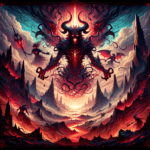Kings of War rewards a balanced approach to army building. While the raw power of melee units is undeniable, their ability to reliably break high-defense foes on the initial charge is often overestimated. Let's dig deeper into the strategic strengths of ranged units and why they deserve a more prominent place in your Kings of War strategies.
In particular, if you’ve looked at my analysis of Elo & cost effectiveness (here), you see that melee units outperform ranged units on average. From a Kings of War data analytics perspective, in a 1v1 context, this is almost certainly true. However, I suspect we often overestimate the value of melee units and underestimate shooting. Let me show you why conventional Kings of War strategy thinking might be wrong.
Challenging Melee Dominance: High Defense & Counterattacks
A typical Defense 5 unit with a solid nerve value (15/17) is surprisingly resilient. To consistently break these units, you'll often need to commit to multiple charges, draining resources and potentially leaving your melee units vulnerable to counterattacks.
For example, take a hammer like a horde of zombie trolls (18 attacks hitting on 4s with CS(2)). What percentage of the time do you think they should break a standard Defense 5, 15/17 uninspired unit on a single charge? If you peeked and saw the Undead Army Review, you’d know that the answer is... 6.5%. In other words, even a standard 18-attack hammer will struggle to break a unit in a single go, which is why adding sharpness or double-charging has so much value in a piece trading game like Kings of War.
Here’s where ranged units come in (and the value of data analytics in Kings of War).
Ranged Units: More than Just Damage Dealers
Focus Fire: A Scalpel, Not a Hammer
By concentrating ranged fire, you can eliminate specific threats or critically weaken key enemy units. This targeted approach allows you to shape the battlefield before melee combat even begins. In this respect, it’s often like extended melee combat with an immensely movable unit: you can get “virtual” multi-charges by focus firing down an opponent, rather than dealing with the intricacies of movement.
Plink Damage: Death by a Thousand Cuts
Additionally, even seemingly minor ranged damage adds up over time. This consistent pressure softens targets, making them easier to finish off with a decisive melee charge. In other words, even if your horde of zombie trolls can’t rout the enemy in one go on its own, if you shift that combat by just a few extra wounds from plink damage, suddenly you’re able to take off opponents in a single charge.
Zone Control: Dictating Enemy Movement
Beyond the actual damage, the mere threat of ranged attacks forces opponents to react. This can disrupt their plans, create exploitable openings, or force them into unfavorable terrain. This is especially useful against newer players. If you have the shooting advantage, you force them to come to you, often on your terms.
Throw down a volley gun and lock down a portion of the board; bring up some high-variance siege artillery and threaten enemies with dice spikes. This forces your opponent to move quickly instead of waiting things out.
Psychological Warfare: The Power of Uncertainty
Finally, opponents under ranged pressure are more prone to errors. Ranged units can bait them into rash charges or ill-conceived maneuvers, giving you the tactical edge. In particular, high-variance ranged units like artillery always have a chance of doing catastrophic damage. Similar to handling large flyers in an opponent’s backfield, the psychological impact of ranged attacks can outweigh their average on-field effectiveness.
Counterargument: Yes, But...
So maybe you’re convinced that shooting can play an important role. If that’s true, why don’t we see more shooting-heavy lists dominating the tournament scene? Here are a few reasons:
Shooting Can Be Very Match-Up Dependent
In particular, Nightstalkers with army-wide Stealthy are a hard counter to shooting lists. Stealthy reduces the effectiveness of shooting attacks, making it difficult to justify investing heavily in ranged units. If your opponent uses spells like Veil of Shadows to protect key units, you may struggle to find enough high-quality targets to justify your investment.
Mitigation Strategy: Diversify your ranged attacks with units that have different attack types or special rules. For instance, units with Blast or Piercing can still be effective against high-defense or stealthy targets. Alternatively, consider magic users with spells that bypass traditional shooting restrictions and can target stealthy units directly.
Shooting Can Be Very Terrain Dependent
A bad table that minimizes shooting lanes might mean that you wasted a lot of points on something that isn’t adding value. Dense terrain can block line of sight and provide cover, reducing the effectiveness of your ranged attacks. In a tournament setting, you often have no control over the terrain setup, which adds an element of unpredictability to the effectiveness of your shooting units.
Mitigation Strategy: Scout the battlefield before deploying your units and adjust your strategy accordingly. Positioning is key—place your shooting units in elevated positions or areas with clear lines of sight. Also, consider including units with the ability to move and shoot (especially with steady aim), giving you more flexibility in adapting to terrain challenges.
Shooting Can Be Shut Down by Fast Flyers
Fast flyers or other highly mobile units can quickly engage and disorder your shooting units, rendering them ineffective in subsequent turns. When disordered, most shooting units suddenly turn into nothing more than bad infantry.
Mitigation Strategy: Protect your shooting units with screens of cheap infantry or cavalry to absorb charges. Additionally, support your shooters with counter-charge units positioned strategically to respond quickly to threats. Units with high nerve values or special abilities like Nimble can reposition and continue to contribute even when under pressure. Or consider using ranged units like Villein Bowmen, who will only put out 2-3 wounds per turn in the horde, but because of phalanx, it’s a bad trade for an enemy to send fast cav or a flyer after them. In other words, you’re playing the meta-game of making your unit annoying but not so annoying it’s worth the investment of points for your opponent to deal with.
Optimizing Ranged Units in Your Army
To harness the full potential of ranged units, consider the following strategies:
Balanced List Building
Instead of focusing solely on shooting or melee, aim for a balanced list that incorporates both elements. This approach allows you to adapt to different opponents and battlefield conditions. For example, a core of solid melee units supported by a few key ranged units can provide both the punch and the flexibility you need.
Synergistic Combinations
Look for units and abilities that synergize well. For instance, pairing shooting units with spellcasters who can cast Wind Blast (to push enemies into unfavorable positions, such as back into terrain if they lack pathfinder) can create powerful combos.
Tactical Deployment and Movement
Deploy your ranged units in positions where they can cover key areas of the battlefield. Use terrain to your advantage—elevated positions, clear lines of sight, and defensible locations can maximize the effectiveness of your shooters. Additionally, be prepared to reposition your units as the battle evolves, using their mobility to maintain optimal firing positions.
Conclusion: Rethinking the Role of Ranged Units
While melee units are often seen as the backbone of Kings of War armies, ranged units offer unique strategic advantages that can be game-changing when used effectively. From softening up tough targets and controlling enemy movement to exerting psychological pressure and exploiting terrain, ranged units can provide a crucial edge in battle.
By understanding and leveraging the strengths of your ranged units, while mitigating their weaknesses, you can create a more versatile and resilient army. So, next time you’re building your Kings of War list, give those ranged units a second look—they might just be the key to your next victory.
Remember: The best armies are those that are well-rounded and adaptable. Don’t underestimate the power of a well-placed volley or the psychological impact of a looming artillery threat. In Kings of War, every unit has its place, and mastering the balance between melee and ranged can elevate your game to new heights.
Resources:



